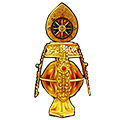(The following translation is the 9/23/2012 dharma discourse related to Mahasri only.)
<9/23/2012 Mahasri Homa Ceremony Discourse of Living Buddha Lian-sheng at Rainbow Temple, USA>
Today we are conducting a homa for Mahasri. This is Mahasri's mudra (Grandmaster demonstrates the mudra). It's the Lotus Mudra, the fully blossomed Lotus Mudra, but the two ring fingers are bent inwardly a little. This is Mahasri's mudra. Mahasri's seed syllable is ''shili'' which means ''auspicious.'' Mahasri's mantra is ''Om, ma-ha, shi-li-ye, so-ha.'' The syllables ''ma-ha'' means ''great'' whereas ''shi-li'' means ''auspicious.'' Together, it means that Mahasri is the Great Auspicious Goddess of the Great Auspicious Heaven, of the universe, and of the entirety of space. The meaning of ''so-ha'' is that Mahasri is able to bring the affairs of all beings to complete perfection. I have written about Mahasri in Book 54 Vajrayana Karma Practices, Book 102 Nectar of Dharma, Book 108 Great Legends of Rainbow Villa, Book 114 Spiritual Practices of Vajrayana, Book 204 The Divine Book, and so forth. Mahasri has a Prayer for Dream Divination Practice. If one prays to Mahasri, she will provide guidance through one's dreams. Mahasri also has a practice to foretell good or bad fortune. It is called ''zhanbu'' and is a method of sortilege. In Tibetan this practice is called ''daqua.'' It is a dharma of Mahasri.
In Japan, Goddess Mahasri appears in the Great Auspicious Heaven as a goddess who is warm, friendly, and very pretty. She carries an auspicious fruit in her hand, wears a phoenix crown, and looks extremely peaceful and beautiful. In Tibet, however, Mahasri is depicted as wrathful as a fierce Vidyaraja. She rides a horse with an eye on its rear end. If you see a horse with an eye on its rear end, then you can be sure it's a depiction of Mahasri.
This is the Mahasri of Vajrayana Buddhism. She is easy to recognize. The Vajrayana Mahasri can eradicate calamities and fight one's enemies. She is fierce and awesome. Mahasri is depicted as either extremely beautiful or extremely fierce. The Mahasri of Eastern Vajrayana is extremely beautiful whereas the Mahasri of Tibetan Vajrayana is fierce.
As for the background of Mahasri, she is considered the daughter of Hariti and the Dragon King Takshaka, who is one of the Eight Great Dragon Kings. Her older brother is Vaisravana. Questions between the Buddha and Mahasri were recorded in a sutra. Buddha questioned Mahasri ''Where do you live?'' Mahasri replied ''I live in the Auspicious Palace in the northerly regions of Mt. Sumeru. The Auspicious Palace is one of the palaces of Vaisravana.'' According to the sutra, this was the answer she gave to Shakyamuni Buddha. She lives in one of the palaces of her older brother. (please refer to the Buddha's Discourse on the Supreme Sutra of Golden Light, Scroll Eight, Chapter 17, Mahashri Enrichment)
The principal deity of last week's homa was Vishnu (Brahma of Universal Purity.) Vishnu is the god of protection and Mahasri is his wife. According to my knowledge, there are twelve emanations of Mahasri, so there are twelve Mahasris. Actually, there is some correspondence with Taoism. In Tibet, Mahasri was a deity of the Bon religion who later became a protector of Buddhism. The twelve emanations of Mahasri are quite similar to the Twelve Xinu of Taoism. I am only able to recite the mantra of Taoist Liujia in Taiwanese. Please listen: ''The Shangqing Shangdi, the Donghua Dilijun, Bestow on Lian-sheng the Divine Book of Liujia, Authority to command the deities of Liujia Liuding, freedom to travel to the celestial realms of Twelve Xinu and the Five Goddesses of Nayan Heaven, Chief of the Three Divine Generals of Fire, Ocean, and Wind, Each Divine General leads a million divine soldiers, Assist in Lian-sheng's power, supernatural ability, transformations, and merging with the Tao.''
The Twelve Xinu in the mantra are the Twelve Mahasris. The Taoist Five Nayan Goddesses are the Five Longevity Goddesses. The mantra has some connection with Vajrayana and Buddhism. If one wants to cultivate Mahasri's Dream Divination Practice then one may cultivate according to the practice I set out in Book 114 Spiritual Practices of Vajrayana. There is also Bagua fortune-telling as described in Book 204 The Divine Book. In these books you can learn the dharma practices of Mahasri.
In Eastern Vajrayana, which is Japanese Vajrayana, Mahasri's primary function is to bestow wealth on sentient beings. In Tibetan Vajrayana, however, Mahasri can eliminate misunderstandings and karmic forces as well as eradicate all enemies. The two Mahasris are different, and their respective cultivation practices are also not very similar. Mahasri has vast power and is very, very honorable. Her power is truly mighty. This concludes my discussion of Mahasri.
Translated by True Buddha Translation Team
Translator: Henry Wolf
Editor: DJ Chang




